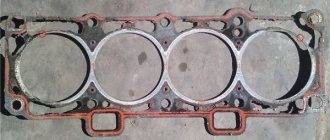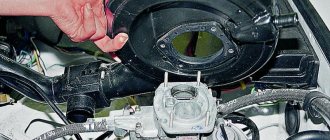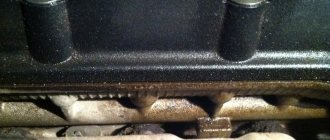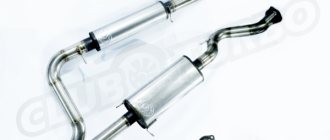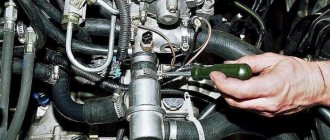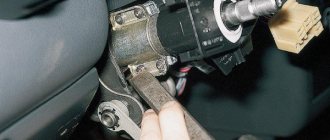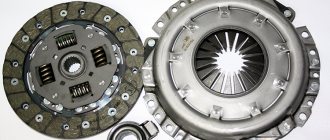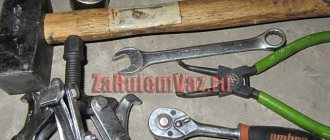The exhaust manifold is a metal part of the car that is designed to collect and further release exhaust gases from the combustion chambers of each engine cylinder into the exhaust pipe. As a rule, the manifold is most often made of cast iron or stainless steel. On one side, the manifold is attached to the cylinder head, on the other side - to the resonator or catalyst, depending on the model and configuration of the car.
Where is the exhaust manifold gasket located?
At the junction of the cylinder head and the manifold, a gasket is installed, which serves as a seal at the junction. This gasket is made of pressed cardboard and is a consumable material. Since the manifold operates in elevated temperature conditions, the gasket must be able to withstand such conditions. Its burnout or loose fastening can lead to exhaust gases escaping into the engine compartment. This can lead to an unpleasant smell of used gasoline, hot gases getting back into the cylinders, which can cause the engine to malfunction, and ignition of the engine compartment, since high-temperature gases can ignite gasoline in the injection system. That is why the manifold gasket must always be in good condition and, if necessary, subject to timely replacement.
Exhaust manifold: description of the device and principle of operation
The exhaust manifold is the first component of a car's exhaust system. Structurally, these are several channels combined into one common channel that transmits exhaust gases further along the exhaust tract. Exhaust manifolds are installed on all types of internal combustion engines, regardless of their brand or purpose. Exhaust manifolds are necessary to collect and remove exhaust gases.
A properly designed and selected manifold contributes to more efficient ventilation of the cylinders, which means more optimal filling of the air-fuel mixture. A similar effect is achieved due to the movement of exhaust waves inside the manifold channels.
Replacing the exhaust manifold gasket
When the first signs of a broken gasket appear, which are: unstable engine operation, the appearance of soot in the area of the broken gasket, a strong smell of exhaust gas in the engine compartment and a characteristic whistling sound, you must immediately replace the gasket.
- First, let the car cool down to avoid possible burns when touching the manifold and other parts that are at high temperatures.
- Then disconnect all parts that prevent the manifold from being dismantled. Typically, these include: an air filter, a carburetor or (for fuel-injected cars) an injection system and a heat shield.
- After all the interfering parts have been removed, it is necessary to treat the nuts securing the manifold to the engine with WD-40 liquid , since the nuts, under the influence of high temperatures, “stick” and can cause difficulties when unscrewing them. After the liquid is absorbed, unscrew the nuts. If one of the nuts still won't come off, heat it with a gas burner. In this case, it will get out without any problems.
- Now remove the exhaust manifold, remove the gasket and sand the manifold-engine interface to remove any remaining gasket. Treat all cleaned surfaces with graphite lubricant and install the gasket in place.
- Screw the manifold to the engine with new nuts, which also need to be pre-lubricated. The nuts are tightened from the middle of the manifold to the edges. This ensures increased tightness of the parts being connected.
Preparation stages
To replace the manifold or its gasket, in any case you will have to dismantle the VK. But before you get to the element you are looking for, you will first need to go through some preparatory steps. Namely, tighten the fasteners, and then remove the air filter and carburetor if the first stage does not help.
This is interesting: Adjusting doors on a Lada Granta - what to do if the front door does not open from the outside: do-it-yourself repairs
| Stage of work | Your actions |
| Tightening the fastenings | Often, loose manifold fastenings caused the entry of contaminants, which disrupted the performance of the exhaust system. If the tightening did not give any result, then the gasket is definitely burned out or the collector itself is damaged, which is less likely |
| Removing the air filter |
|
| Removing the carburetor | Removing the carburetor is carried out in the following sequence:
|
Dismantling the unit
All dismantling work must be carried out only on a cold engine. To make it easy to unscrew all fasteners, you can pre-treat them with WD40, several hours or even a day before the repair begins.
Part selection
21083-1008081 – original catalog number of the gasket for the intake and exhaust manifold. It consists of two parts or, on newer models, one. This part is produced at the AvtoVAZ plant. The average cost is 250 rubles per piece (if there are two of them) or 450 rubles (for a whole one).
One-piece manifold gasket A gasket that consists of two parts A one-piece gasket and one that consists of two parts together
In addition to the fact that there is an original part, you can also find a number of analogues that are recommended for installation. Let's consider which gaskets can be installed under the VAZ-2114 manifolds:
- Trialli GZ 102 0013 is a well-known Russian manufacturer that produces a wide range of analog parts for domestically produced cars. The cost of the gasket is 200 rubles per piece.
- AJUSA 13065200 is another domestic manufacturer that has won consumers over the quality of its products. The cost of the product is 450 rubles.
- Ukrainian also produces and supplies this gasket. But, if you look at it, the quality of the product leaves much to be desired, since the resource is designed for only 20,000 km.
Required tool for replacement
Before you begin the process itself, you need to decide on the necessary tools. To remove the exhaust manifold on a VAZ 2114 in order to replace the gasket or entire part, you will need the following tool:
- open-end and ring wrenches for 8, 10, 13, 17;
- wrench with heads 17, 19;
- screwdrivers, pliers.
It is also a good idea to have tools such as a Dremel, nut saw or nut pick on hand. As a rule, the fasteners on the exhaust system parts stick tightly.
A few days before your planned repair, begin treating accessible nuts with WD-40 or another penetrating lubricant. Repeat the operation 2-3 times. This will make the task of removing the manifold a little easier .
The question often arises: is it worth using a sealant after removing and replacing the gasket? Experts believe that if you apply sealant to the gasket, it should only be high-quality silicone. A bad sealant can bring a lot of trouble to a VAZ 2114 engine: when it burns out, it turns into “pellets” that are pulled into the crankcase. And this is unnecessary contamination of the piston system.
Now that everything is prepared, you can start working directly. In order for the manifold to be removed without any problems and rusted bolts not to create trouble, everything must be lubricated with WD-40 before performing the operation. It is advisable to do this several times. Before performing the operation, you need to think again, weigh everything and calculate your strength.
Example of intake manifold gasket location
Throttle body and intake manifold switching system:
1 – upper part of the intake manifold; 2 – bolt, 10 Nm; 3 – bolt, 20 Nm; 4 – gasket; 5 – idle speed stabilization valve N71; 6 – bolt, 10 Nm; 7 – bolt, 6 Nm; 8 – flange; 9 – base of the intake manifold; 10 – gasket; 11 – bolt, 10 Nm; 12 – vacuum chamber of the intake manifold switching valve; 13 – bolt, 20 Nm; 14 – throttle unit; 15 – gasket; 16 – bolt, 20 Nm; 17 – mechanical valve of the exhaust gas recirculation system (EGR); 18 – EGR temperature sensor G98; 19 – bolt, 10 Nm; 20 – gasket; 21 – bolt, 10 Nm
We provide a 6-month guarantee on replacement of intake and exhaust manifold gaskets
How to remove the exhaust manifold on a VAZ 2114
Replacing the exhaust manifold and gaskets on a VAZ 2114
Exhaust manifold. This is a device responsible for driving quality, without which comfort is impossible. It's still there, and there's no exhaust smell under the hood that can be drawn in through the cabin opening. Repair of leaks in the exhaust manifold of a VAZ 2114. Repair required. Fortunately, this does not happen urgently; you can prepare in advance and choose the right moment.
Exhaust manifold for VAZ 2114
Causes of failures
The main factor that accounts for 90% of failures in the exhaust manifold on VAZ 2114 cars is high temperature, and not the quality materials that make the parts. During operation, the steel is repeatedly heated and cooled, which leads to the appearance of cracks in the body. This is a common occurrence for VAZ cars older than 7-8 years.
Gas stations offer argon crack welding services. However, for a number of reasons, this lesson is useless for a car older than 7 years.
1) Removing and installing only the exhaust manifold will cost about 2.5 thousand rubles. Taking into account the work of the welder and other measures, the cost of repairs can be 4-5 thousand rubles. If you do the work yourself, it will be cheaper to buy a new part.
2) Welding, even argon, destroys the structure of “tired” metal. A finished item rarely lasts longer than a year before new discoveries emerge. Old car. the sooner the problem returns and the collector must be removed again.
If the car is more than 8 years old and there are problems with cracks in the manifold, the part should be removed and replaced with a new one.
Symptoms of Failure
What is needed for repairs
Replacing the exhaust manifold gasket involves using the following means:
- set of spanners;
- slotted and Phillips screwdrivers;
- sharp knife or spatula (to remove old gasket);
- a container with a wide neck with a volume of at least 5 liters (for draining coolant);
- rust preventative (WD-40 or similar);
- dry rags.
Important: replacing the exhaust manifold gasket 2114, like other VAZ models, requires preliminary draining of the coolant. Otherwise, you risk flooding the engine intake windows with it.
How much does a repair at a service station cost?
How much will it cost to replace the exhaust manifold gasket? The price for this type of work depends on the type of engine (carburetor, injection, 8-valve, 16-valve), the model of the seal itself, as well as the prices of the service station where you plan to repair your car.
On average, the work itself, together with the seal, costs somewhere around 1,500 rubles.
But you don’t have to spend money on work. Replacing the VAZ exhaust manifold gasket can be done on your own without much difficulty. Especially if you have a set of hand tools and you have even the slightest idea about the design of your car’s engine.
